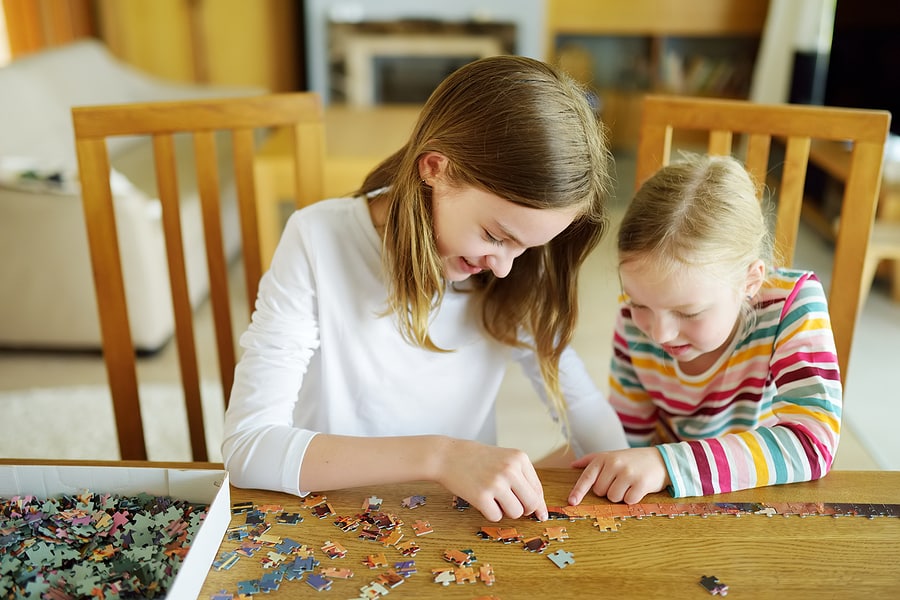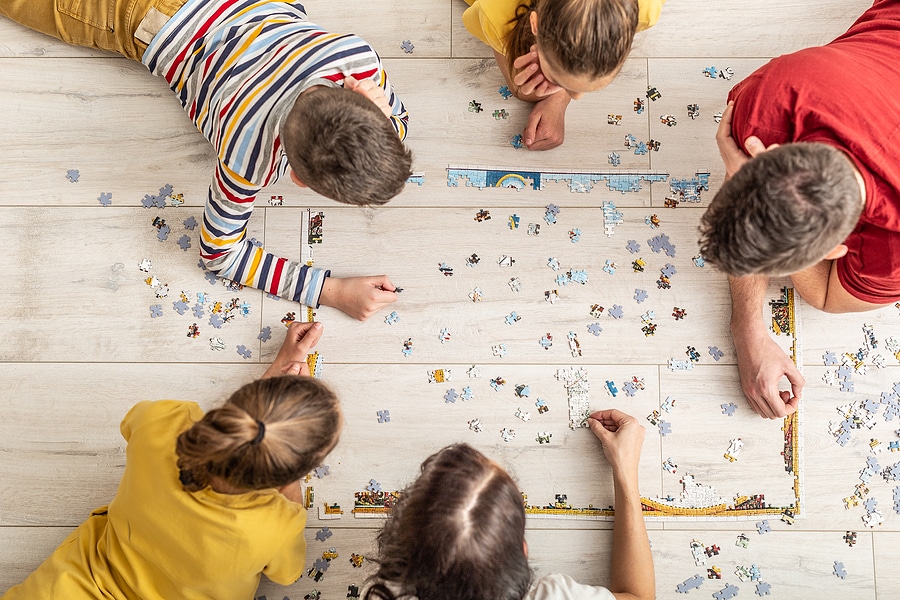Last Updated on February 23, 2024 by JigsawPuzzleGuru
Did you know that the first jigsaw puzzles (as we know them at least) date back to the 1760s in London, England? That makes the humble jigsaw officially older than the United States of America. Since that time, jigsaws have become an object of fascination —and sometimes frustration — of individuals and families around the world. Without a doubt, it is a great family bonding activity!
In today’s blog, we’re thinking about how a jigsaw is beneficial for family bonding. Do you and your family do jigsaws together? Are you afraid it might cause more problems than it solves? It’s intuitive to worry about it, but believe us when we tell you that the benefits of family jigsaw solving far outweigh any of the negatives.
Table of Contents
How Family Jigsaw Solving Bonds Families Together
1. Collective Problem Solving
Families are more cohesive and functional when they can work together to solve problems. A good exercise that fosters this sense of camaraderie is in solving the jigsaw puzzle. Each member of the family can bring to the table different strategies and styles to try out, and then others can hone and finesse those ideas with added detail.
Think about what that means. Let’s say Dad has the idea of starting by trying to identify all the pieces that belong to a certain section of the jigsaw and putting them together. The daughter might then chime in with a finessing detail like “How about we start with the sides because they have flat edges. Brilliant!
Though it seems a simple and meaningless process on the surface, what has just happened there is members of the family have come together to solve a common problem. It’s now being applied to solving a jigsaw puzzle, but there’s no reason it couldn’t be applied to a more serious situation later like a family dispute, or trouble on a vacation.
2. Quality Time
Let’s face it, unless it’s a 20-piece jigsaw for pre-school kids, any jigsaw is going to take more than just a minute or two to solve. When families come together to solve jigsaws, they’re spending good amounts of quality time together in a day, quite possibly over multiple days as, step by step, they build their picture together.
Another fact about jigsaw solving is that it’s not a loud activity, nor are there distractions from music or television, so the family will make conversation and talk to each other. It’s quite easy to be sorting through pieces looking for straight-edged side pieces and simultaneously asking the kids what they learned at school that day or what else is going on in their lives.
Quality time and good communication is an excellent way for the family to feel more together. That kind of talk is what helps members of the family to understand each other better, and that, in turn, leads to a more functional and cohesive family life. It’s often in those more unguarded, relaxed, and unforced moments in which family members really talk openly to one another.

3. Sense of Achievement
Many jigsaws are extremely challenging. There’s a tremendous feeling of achievement that can be attained by successfully solving one. Just imagine that divine final moment where there are perhaps four pieces left to put in, one for each member of the family. Each person takes up a piece and you complete your challenging jigsaw in one last maneuver of puzzling brilliance.
When the family has worked together on the puzzle, they share in the achievement, and that moment of common ground is a great way to bond. It gives you a shared experience that all members of the family can recall fondly and associate with positive emotions. They may also reflect not just on how they managed to finish the jigsaw, but also how they overcame disagreements on strategy and approach to the jigsaw. This brings us neatly to the next bonding element: empathy.
4. Greater Sense of Empathy
We mentioned just above how family members will reflect on how they overcame disagreements and problems in solving the jigsaw. Listening to one another and seeing how another family member’s strategy was successful can cause others to reflect in an empathetic way. A brother may see his sister in another light, and start to consider their relationship a little differently in the future.
It sounds like a lot to come out of one jigsaw puzzle, but most significant developments in family relationships are built up from an accumulation of small steps like this. When you work regularly on jigsaws together, different insights about other members of the family will come each time.
5. It’s Fun!
Finally, it has to be said: jigsaws are fun! This is especially true when you work on the puzzle together. Jigsaws are a great mental exercise for anyone, but trying to take it on alone can be daunting and frustrating. When others are sharing in your challenge, then there’s always the upbeat and positive encouragement you get from your fellow family jigsaw puzzlers that helps spur you on to keep going and reach the end. The entire experience, though still just as mentally taxing, becomes more fun.
Conclusion: Put The Pieces to Complete the Puzzle and Gain Harmony
These 5 pieces come together to create an even bigger picture of the value of jigsaw puzzles. They bring the family together to solve a common problem, to share quality time in reaching a difficult end with good humor and empathy, all of which deliver the final result and a great sense of achievement. The fact that they do that together makes it more fun, and it makes the family stronger. The jigsaw puzzle is a great family bonding activity!

